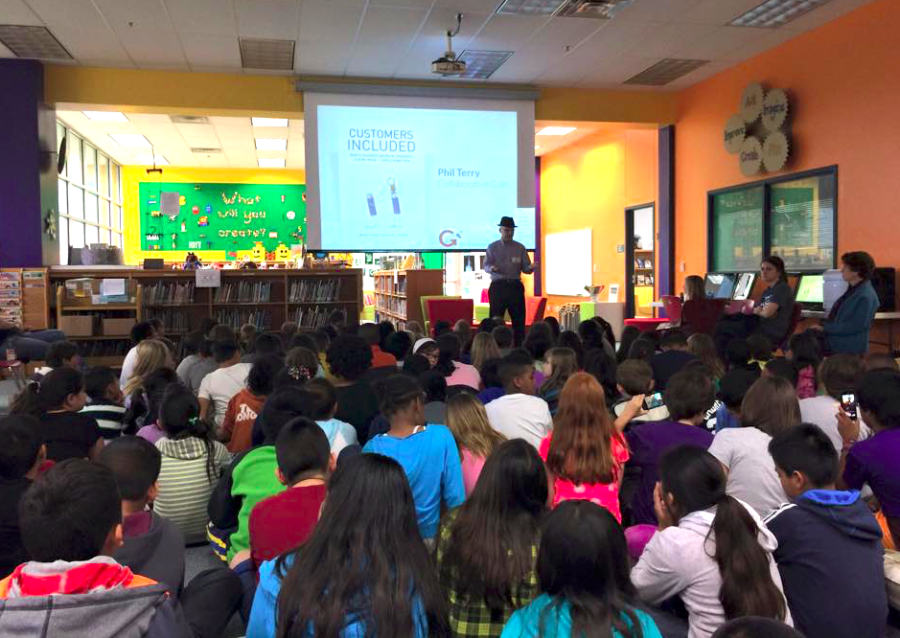
At 11:30am last Monday, I was nervously standing in front of one of the most intimidating audiences I’ve yet spoken to: 110 third graders assembled at Christie Elementary in Plano, Texas.
I have keynoted large conferences, spoken at companies like Apple and Warby Parker, sat with senior executives from many other banks, retailers, and Silicon Valley leaders, but I’ve never had to give my talk to third graders.
How would I keep their attention? Would they really care about innovation and new product development?
I would not have thought so but they had had a homework assignment that touched on the PlayPump, one of the case studies in Customers Included. And my cousin, the mother of one of these third graders, noticed it and talked to her son about it, who then took my book to school and shared it with his teacher, Ms. Twining. She borrowed it, read it and liked it.
So that’s how when my book tour took me to Texas I found myself staring at a bunch of third graders in the library (or what they now call the “Learning Commons”) of their school in Texas.
I told the assembled nine year olds that before I discussed the PlayPump and what happened – before we talk about how to get products right, I wanted to talk about how to mess up products.
This ‘inversion’ game is borrowed from the 19th century mathematician, Carl Gustav Jacoby, who believed that to really understand something, he had to invert it. In other words, turn it upside down. So Jacoby would have said to these third graders that if they wanted to understand how to make a good product, then they should first spend some time considering how to make a bad product.
I have started almost all my “Customers Included” talks in the last year with this inversion exercise. Everywhere I go audiences love this game.
It’s a way for people to give expression to their frustrations – as customers, as employees, as people who have the experience of not being included.
But would the third graders like it?
I outlined the game – and told them to shout out ideas for creating things that don’t work. They almost immediately started throwing out all kinds of ideas including one kid’s suggestion that adults should make something for kids and “never spend any time with us.” That blew me away.
Then we had some other contributions. One kid said “make us eat broccoli and spinach.” In response, another kid yelled out, “But I love broccoli.”
Adults in my talks tend to be more orderly – and give a narrower range of responses. These kids disagreed, shouted, rambled, and, remarkably, hit on some gems and, yes, some bloopers. One kid eagerly jumped up to say something and then realized he didn’t know what to say and sat down.
Another student was quite disappointed and let me know it when she realized I was not the inventor of the PlayPump. Other kids shouted out of turn. It was definitely my most unruly crowd, but I liked that – preferred it to the quieter adults.
When I asked them why they thought we were playing this game, they gave me the best answer I’ve yet received. One kid stood up and said “because mistakes are great to learn from.”
One of the biggest challenges that I see product managers and others face is that they themselves are too conservative, boring, and afraid to make mistakes. I recently spoke at a company in the business of fun and the place was, well, not fun.
These third graders seemed not yet jaded by cynicism, or numbed by the latest jargon, management fad, or conservative business environment. They can be more direct, honest, and playful. They are also more messy. And, it turns out that that messiness in particular was the thing I liked the most: it was refreshing, energizing, and exhausting.
Product managers, designers, entrepreneurs, and business leaders need to be more messy. Listening to customers is messy. Listening to employees is messy. Making mistakes is messy. Messy is part of the picture. And one place they can learn to embrace messy more may be their local elementary school.
Whether designing for kids or adults, more product developers should figure out how to spend some time with third graders. It’ll certainly be fun, definitely exhausting, somewhat strange – but it’ll also help them to get a little bit more messy.
And that just might help them innovate and create some great stuff.
– Phil
P.S. Special thanks to the terrific teacher, Ms. Twining, who invited me. She brings a great energy and spirit of innovation to her third graders. They are lucky to have her as a teacher.